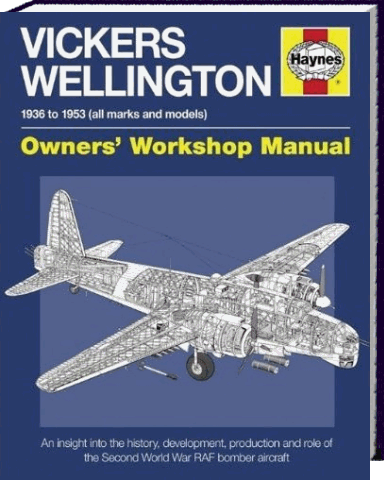Vickers Wellington Manual
An insight into the history, development, production and role of the Second World War RAF bomber aircraft
by Iain Murray - published by Haynes Publishing
Details
by Iain Murray - published by Haynes Publishing
Details
Published 6th December 2012 and AVAILABLE NOW - hardcover, 160 pages (26.7 x 21 x 2 cm approx.), including 150 colour and 100 black & white illustrations (photos and other images).
The book is primarily a technical manual, giving details of the special geodetic construction of the aircraft and other aspects, including the different engines used,
of all the varied marks and variants. A technical history and service history of the aircraft with Bomber Command, Coastal Command and elsewhere are also included, as well as
sections on the crews' and engineers' views. Sideboxes include extra information on topics such as the Wellington in the movies and a "spotter's guide" to the different marks.
The book takes as its main photographic subject N2980 "R for Robert" on display at Brooklands
Museum, the only remaining complete Wellington to have seen active service. MF628, the only other remaining complete Wellington, is currently at the
RAF Museum at Cosford undergoing restoration, but photographic access to this aircraft could not be
obtained at a reasonable price.
The Haynes manual format does not permit the inclusion of footnotes or references, but this reference list pertains to the book as printed.
Originally available in hardcover, also available in softcover.
Outline of Contents
- Introduction
- The "basketweave" bomber
- The development and theory of geodetics
- Manufacturing the geodetics
- The Wellesley
- The Wellington prototype - B.9/32
- Production
- Chapter 1 - The Wellington Story
- Theme and variations - the Wellington marks
- Wellington's twin - the Warwick
- Wellington developments - Windsor and Viking
- High-altitude Wellingtons
- Test-bed Wellingtons
- The "24-hour" Wellington
- DWI - Minesweeping from the air
- Chapter 2 - The Wellington at War
- Service with Bomber Command
- Service in the Middle East
- Service in the Far East
- Service with Coastal Command
- Service with Operational Training Units
- Service with other air forces
- Chapter 3 - Anatomy of the Wellington
- Fuselage / wings / empennage
- Fabric covering / flaps / ailerons
- Nacelles / bomb bay / undercarriage
- Pilot's controls
- Turrets
- Main systems
- Emergency equipment
- Wireless operator's station
- Navigator's station
- Bomb aimer's station
- Coastal Command equipment - ASV Mk.II and III, Leigh light
- Weapon loads
- Chapter 4 - Engines
- Bristol Pegasus, including propellers and supercharging
- Bristol Hercules
- Rolls-Royce Merlin
- Pratt & Whitney Twin Wasp
- Chapter 5 - The Loch Ness Wellington
- Introduction - why is "R for Robert" an historic aircraft?
- History
- Location
- Recovery
- Restoration
- Chapter 6 - The Crews' View
- The pilot's view
- Cockpit drill
- The gunner's view
- Gun turret drill
- Emergency drill/ditching drill
- Chapter 7 - The Engineers' View
- Servicing and maintenance
- Re-arming drill
- Bombing-up
- Recovery of crashed aircraft
- Repairing damage
- Appendices
- Appendix 1 - Glossary & Abbreviations
- Appendix 2 - Manufacture and Conversions (statistics, for Wellington and Warwick)
- Appendix 3 - Squadrons Operating Geodetic Aircraft (statistics, for Wellesley, Wellington and Warwick)
- Appendix 4 - Bibliography
- Appendix 5 - Useful Contacts
LAST CHANCE - stocks of new copies of this book are increasingly rare, though still available from
Amazon








